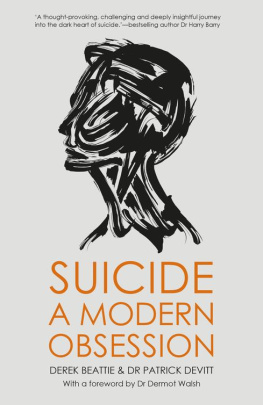We would like to acknowledge the patience and assistance of our friends and families. Thanks to those who gave up their time for interviews: Professor Ella Arensman, Dr Justin Brophy, Rene Duignan, Joan Freeman, Dr Declan Murray and Dr Dermot Walsh. Carl OBrien of the Irish Times was especially helpful and we are grateful to those families who opened up their grief to Carl in such a public way. Sean OKeeffe of Liberties Press has remained enthusiastic since we first approached him with our idea for this book, and he has been a constant encouragement. The professionalism and guidance of our editor, Sam Tranum, and all the staff at Liberties have been invaluable. This work has also benefitted from the advice of Dr Selena Pillay, Stephen Shannon and a number of other colleagues.
I am delighted to provide a foreword to this contribution to an issue that has become increasingly the subject of debate and media attention in Ireland in recent years. Such consideration, not all of it well informed, is understandable, as suicide is a major cause of mortality, particularly among young males, and therefore constitutes a significant public health problem. This book brings examination and critical appraisal to bear on the issue of suicide internationally and within Ireland. It includes an historical review of the matter, from antiquity onwards, looking at how the taking of ones life was perceived in widely different cultural settings. It also reviews causes and examines preventive endeavours. It does not neglect the distress of those family and others affected by each suicide and the provisions necessary to ease their pain. And it includes some evocative case histories.
Within the narrower domestic focus of Ireland, issues relating to suicide, its public perception, and indigenous preventive strategies are examined. In this context, the main interest from an Irish point of view is the original, perhaps controversial focus it brings to bear on the effort expended on prevention, grappling with the issue in the recent Irish context.
During the nineteenth century, the number of recorded Irish suicides was extremely low in the European context and, despite a moderate official increase before the First World War, it fell away again in the post-war decades. It took some time to establish, on a scientific basis, an approximately accurate rate, as distinct from the official rate as returned by the reports of the Registrar General compiled from coroners determinations as submitted to the Central Statistics Office (CSO). Critical examinations of coroners and hospital records of violent deaths revealed that the true rate of suicidal death was at least twice as high as represented in CSO data. Nonetheless, there were reasons for believing that, even allowing for a revised death rate more accurately representing the real situation, Irish suicide rates were still relatively low in the international context.
Then, in the third and fourth quarters of the twentieth century, suicide numbers and rates in Ireland began to rise according to both official and unofficial numbers although the gap between these two assessments had by then closed considerably. By late-century, however, while Irelands overall suicide rate was still in the middle of the European range, the rate for its young males had increased worryingly and was greater than the rates for young males in most other jurisdictions. These suicides were quite often impulsive and carried out in the context of alcohol, by young males not generally perceived as suffering from mental illness in the formal sense, despite the claims by researchers that most suicides occur in persons with established mental disorders. This increase then flattened out in the early years of the twenty-first century. While long-term trends were clear, year- on-year and regional variations within Ireland were also less meaningful because of the small numbers involved.
Youth suicide in Ireland became an issue catalysing considerable popular and political preoccupation with prevention. Organisations active in prevention, small and large, flourished and prospered and competed for considerable resources to pursue their activities. From the 1990s to early 2000s national policy documents were produced advocating numerous intervention typologies. And, more recently, the Health Service Executive (HSE) has identified suicide prevention as one of its major service programmes in mental health. Simultaneously, data has been gathered on persons presenting to emergency departments of general hospitals describing the occurrence of self-harm, and the characteristics of such persons, most of whom, in fulfilment of HSE policy, are evaluated by dedicated nursing staff.
This book points out that much of this activity, some of it resting on inspirational rather than scientific insights, and little of it evaluated in any critical manner, may be of doubtful benefit. Suicide prevention, whether on a population or high-risk basis, is challenging as this book points out. Searching for causal relationships in short-run and unstable data can thwart many a research endeavour, given the rarity of suicide and the wide prevalence of perceived risk indicators. But this publication reaches beyond the domestic scene and examines the relationships between international impacts such as economic recessions, and cultural influences.
A nation has the responsibility to preserve human life, including by preventing suicide. This book highlights the difficulty of this moral and political obligation, given the heterogeneity and complexity of the roots of the tragedy that is suicide.
In July 2012, Irelands then minister for health, Dr James Reilly, described suicide as a tragedy that we are constantly working to prevent. Kathleen Lynch TD , minister of state with responsibility for mental health, reaffirmed the governments commitment to preventing suicide in September 2014 when she stressed that all of the cabinet was very concerned about the high rate of suicide in Ireland. Yet some suicide-prevention campaigners claim that the government is not doing enough to tackle the problem.
It is difficult to level the same charge at civil society and ordinary Irish people. In a country with a population of just over 4.5 million, there are around 400 organisations dedicated to preventing suicide. Typically, these organisations have developed as well-meaning local responses to the tragedy of suicide.
The Irish media are fascinated with the high incidence of suicide among young males in the country and eager to offer suggestions on how this problem should best be addressed. In a 2014 article coinciding with World Suicide-Prevention Day, Arlene Harris of the Irish Times suggested that:
Society has realised that, in order to reach out and help people who are struggling on the brink, the topic needs to be discussed openly, and those who are suffering need to know there is no shame in feeling despair.
Interest in suicide crosses many cultures. A Japanese book, the Complete Manual of Suicide, contains detailed descriptions and analyses of different suicide methods and has sold more than a million copies. The South Korean government is so concerned about the prevalence of Internet content promoting and encouraging suicide that a hundred people are employed there to monitor the Internet for such material. Google generated around 19 million results using the word suicide in November 2014.
So suicide is clearly a topic of enormous public concern and interest. The question is why. Though it may be difficult for those who have lost a friend or relative to suicide to comprehend, it still remains a relatively rare event. In most developed countries, the number of suicide deaths is just about comparable to the number of road-traffic fatalities. While there is significant interest in reducing mortality from road-traffic accidents, the public are not as feverishly gripped by the topic. Why is there apparently more interest in suicide than in road-traffic accidents?













